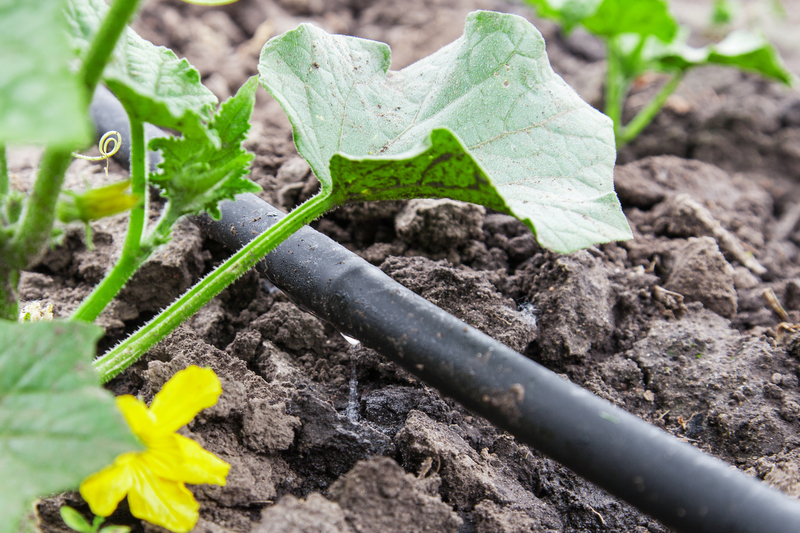In the southern part of the state where I live, several municipalities impose water-use restrictions and bans on certain uses during the Summer months.
One type of ban is watering plants or your lawn, particularly in very late Summer before Fall rains move in; this set-up is ideal for addressing that situation.
Calculate System Size
Before you get out your tools, pick up a pencil and paper and determine how many plants you are able to irrigate. For each load of laundry you run per week, plan on irrigating 1 to 2 fruit trees, 3 to 4 berry bushes, 3 to 4 edible vines, and 6 to 8 smaller perennial plants (such as roses, lavender, or artichokes) per load.
These guidelines are based on 20 gallons of water per load, which is typical for most washing machines.
Dig the Trenches
Washing machine pumps are not very powerful, so the plants to be irrigated should be within 50 feet of the machine, assuming the terrain is more or less flat. A network of flexible tubing buried in trenches below the soil will deliver water to each plant. The trenches can go up and down over modest humps and dips in the landscape, but should not run directly uphill. (the 50 feet doesn’t include any distance that the piping runs down an incline to reach the planting area, as gravity takes care of that part).
Starting from the exterior wall of your home closest to the washing machine, dig a shallow (2 to 3 inches) trench to the nearest plant that you wish to irrigate. Stop the trench at the edge of the “drip line” of the plant—directly below the outermost leaves and branches—and from there dig a trench to the drip line of the next plant, to the next, and so on.
Then dig a trench approximately 10 inches deep and 8 inches wide in a circle around the drip line of each plant. Another option that works well for smaller plants that are planted in a row is to dig a straight trench along the edge of the drip line on one side of the row (up to a maximum length of about 12 feet). The trenches will be filled with mulch to absorb the graywater.
Lay the Pipe and Spread the Mulch
Lay 1” HDPE flexible tubing (often referred to as poly pipe) in the shallow trenches, cutting it and inserting barbed “Ts,” “elbows,” and other fittings where necessary. Run ½” tubing off the main 1” line to each of the deeper trenches, leaving a few inches of tubing sticking out into each trench. Secure the fittings with hose clamps.
Washing machine pumps are only strong enough to push water through 10 to 12 irrigation points at once. If you’re going to irrigate more plants, divide the pipe network into two zones with a three-way valve. The valve should be left accessible in a valve box so you can operate it manually.
Connect the Washing Machine
Locate the flexible drain tube behind the washing machine and remove it from the rigid “standpipe” that drains the wastewater into a sewer or septic system. Connect the flexible drain tube to a 1” three-way valve using a 1” barbed male adapter and a hose clamp. Connect one side of the valve to the sewer standpipe using a 1-inch diameter PVC pipe and fittings, configuring the piping as needed so that the valve is against the wall in an accessible location near the standpipe and at least a couple inches above the height of the washing machine.
Choose the location where the piping will pass through the wall to connect with the tubing outside. Another option is to run the pipe through the floor and outdoors through the exterior wall of a crawlspace of basement.
Run 1-inch diameter PVC pipe from the open end of the valve through the wall, leaving about two to three inches of the pipe protruding on the outside of the wall. Use a 1” pipe strap on either side of the valve to support horizontal pipe and secure it to the wall.
Connect a 1” PVC “T” fitting to the open end of the pipe outside the wall, with the open ends of the fitting oriented vertically. Connect the bottom of the T fitting to the poly tubing on the ground with 1-inch diameter PVC pipe and fittings, as needed. Cover the last bit of poly tubing with soil.
Connect a piece of 1-inch diameter PVC pipe to the top end of the T fitting of sufficient length to rise above the height of the three-way valve indoors. Connect an air admittance valve (also known as an “auto vent”) to the top of the pipe (this device prevents foul-smelling air from circulating back through the washing machine and into the house). Seal the hole where the pipe passes through the will exterior grade caulk, both inside and outside the wall.
This is just one way of collecting and using grey-water.
Another method that extends the distance the water can be spread and does not put strain on the washing machine pump is to collect the water in a rain barrel and build a system that transfers the water from there onto your plants or garden.
To learn more about this method and other ways to utilize grey-water for conservation and common sense reasons, check out Modern Farmer.
